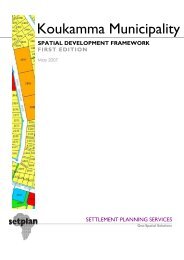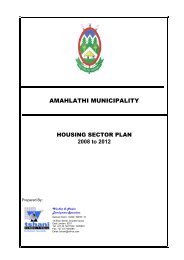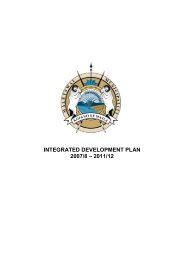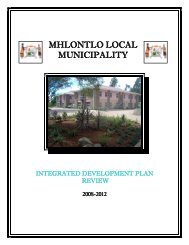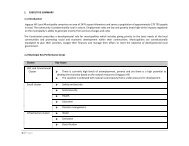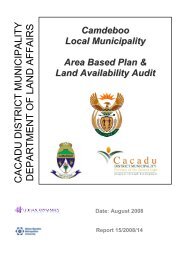intsika yethu local municipality - Provincial Spatial Development plan
intsika yethu local municipality - Provincial Spatial Development plan
intsika yethu local municipality - Provincial Spatial Development plan
You also want an ePaper? Increase the reach of your titles
YUMPU automatically turns print PDFs into web optimized ePapers that Google loves.
7.3 Institutional Performance ManagementAt the beginning of every financial year IYLM shall compile a balanced scorecard which will be specificallymeant for assessing the performance of the <strong>municipality</strong> as an organisation. The balanced scorecard shallbe reviewed by the <strong>municipality</strong>’s Balanced Scored Card Review Forum/Structure. This structure shall sitquarterly to assess the progress of the <strong>municipality</strong> in terms of reaching its targets. The institutionalperformance management approach is important because it allows for an overall picture of the<strong>municipality</strong> and how managers are working together as an organisation in order to reach their targets.The challenge for IYLM is to develop a comprehensive mechanism that will allow for the entire institutionto be properly assessed on a continuous basis in a manner that will provide credible information that canbe used to improve the <strong>municipality</strong>’s all-round performance. At present the <strong>municipality</strong> uses a methodthat ranks the <strong>municipality</strong>’s performance according to three levels. As seen from the table beneathmunicipal performance can fall under the “RED” bracket which represents poor performance that needsurgent attention; The “AMBER” bracket which represents delivery that is only just meets the needs of the<strong>municipality</strong> and is therefore close to poor performance; or the green bracket which bracket representssatisfactory performance.One should bear in mind that the table in question is a simplification of the actual process which in realitywould involve the assessment of many indicators and targets based on the <strong>municipality</strong>’s strategicobjectives and KPA’s.Table 37: Institution Performance Achievement RatingKEY ROBOT LIGHTACHIEVEMENTPERCENTAGEPERFORMANCEDESCRIPTIONRED 50% and Lower Problem Area - Delivery belowpar (Needs urgent attention)AMBERLower than 100% butHigher than 50%Delivery borders on danger area -If performance does not improvewill turn redGREEN 100% and Above Delivery levels acceptable - keepmomentum, sustain and improvewhere there is room7.4 Individual Performance ManagementAssessing individual performance is an integral part of performance managements as it presents detailsabout a <strong>municipality</strong>’s performance that may not necessarily by visible from an institutional perspective.Individual performance management elucidates upon specific areas of excellence, competence andshortfalls within the <strong>municipality</strong>. IYLM uses a performance agreement to document the agreementbetween the employee of the <strong>municipality</strong> and the manager on behalf of the <strong>municipality</strong>. Theperformance agreement document possesses the details of what exactly is expected of the employee for thefinancial year in question. It is also an opportunity for the strategic objectives and goals as stated in theIDP of the <strong>municipality</strong> to be cascaded into the actual work of officials and managers.The core components of a performance agreement include the following:Output Plan: details the outputs which the employee has to deliver upon. Targets are crafted inrelation to the performance indicators that will demonstrate the employees progress in terms ofachieving his/her outputs.Competency <strong>plan</strong>: this refers to the skills and knowledge that an employee should acquire in order toachieve the outputs as set out in the output <strong>plan</strong>.155







